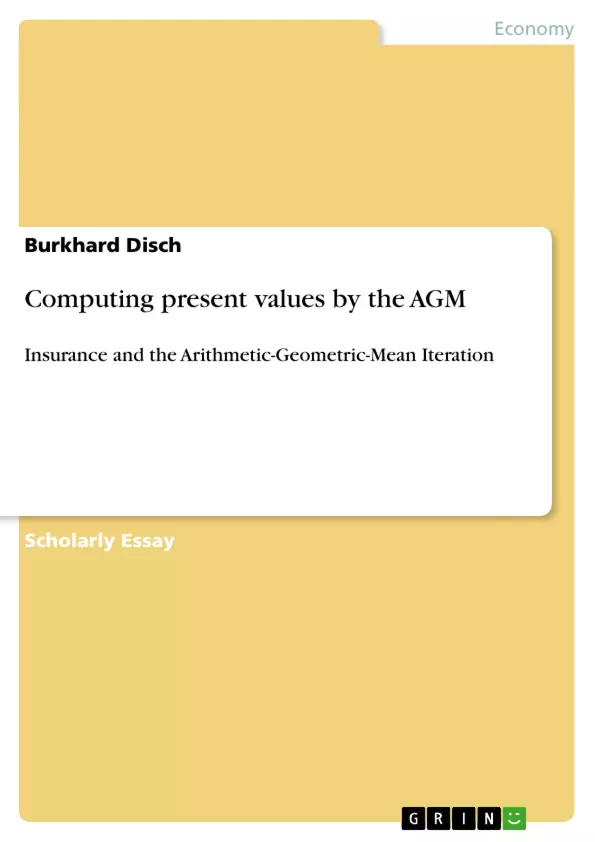Summary
Subject of this paper is a method for computing present values with the Arithmetic-Geometric-Mean iteration (AGM). The classical integral-fomula for present values – as for-mulated by Reichel [1] – is solved explicitly by approximating the integral using exponential or trigonometric sums. Using the Elliptic-Integral Presentation (first kind), sequences are con-structed which converge with second order accuracy in the case of exponential, sinus and co-sine functions. Thus, the present value is defined as the limit of a rapidly converging sequence. Examples demonstrate the procedures.
Zusammenfassung
Die Berechnung von Barwerten mit dem AGM
Inhalt der Ausarbeitung ist die Berechnung von Barwerten mit dem Arithmetisch-Geometrischen-Mittel. Die bekannte Integraldarstellung von Reichel [1] wird explizit gelöst unter Zu-hilfenahme einer Approximation des Integranden mit einer speziellen Form von Exponentialsummen oder trigonometrischen Polynomen. Durch die Darstellung des Grenzwertes des AGM mit dem Elliptischen Integral erster Art werden Folgen konstruiert, die quadratisch ge-gen die Exponentialfunktion bzw. Sinus und Cosinus konvergieren. Dadurch wird der Barwert durch eine rasch konvergente Folge dargestellt.
Beispiele demonstrieren die Vorgehensweise.
Inhaltsverzeichnis (Table of Contents)
- Introduction
- Problem and Basic Assumptions
- Basics on the AGM
Zielsetzung und Themenschwerpunkte (Objectives and Key Themes)
This paper presents a method for computing present values in life insurance mathematics using the Arithmetic-Geometric Mean (AGM) iteration. The objective is to develop an algorithm for calculating these values in a way that preserves information about the distribution of retirement times, unlike traditional methods that use piecewise constant approximations. This approach aims to improve accuracy and efficiency while maintaining a continuous representation of the relevant functions.
- Computing present values in life insurance mathematics
- Preservation of information in the distribution of retirement times
- The Arithmetic-Geometric Mean (AGM) iteration
- Approximation of exponential and trigonometric functions
- Application of classical mathematical concepts to modern actuarial problems
Zusammenfassung der Kapitel (Chapter Summaries)
- Introduction: This chapter introduces the problem of computing present values in life insurance mathematics and reviews a method based on a weight function and a continuous function of the interest intensity. The chapter also defines the distribution function of retirement and presents formulas for the present values in case of endowment and death.
- Problem and Basic Assumptions: This chapter rewrites the integrals for the present values in a more general form, introducing the concept of approximating the integrand by sums of exponential or trigonometric functions. The chapter then focuses on the case of a constant interest intensity and derives key lemmas for computing the integrals in both the exponential and trigonometric cases.
- Basics on the AGM: This chapter introduces the Arithmetic-Geometric Mean (AGM) iteration, a powerful tool for computing complete elliptic integrals. The chapter presents basic properties of the AGM and proves that the limit of the AGM iteration is directly related to the complete elliptic integral. This establishes the connection between the AGM and the problem of approximating functions used in the previous chapter.
Schlüsselwörter (Keywords)
Present values, life insurance mathematics, Arithmetic-Geometric Mean (AGM) iteration, elliptic integrals, exponential and trigonometric functions, approximation methods, actuarial computation problems.
- Quote paper
- Dr. Burkhard Disch (Author), 2002, Computing present values by the AGM, Munich, GRIN Verlag, https://www.grin.com/document/151733



